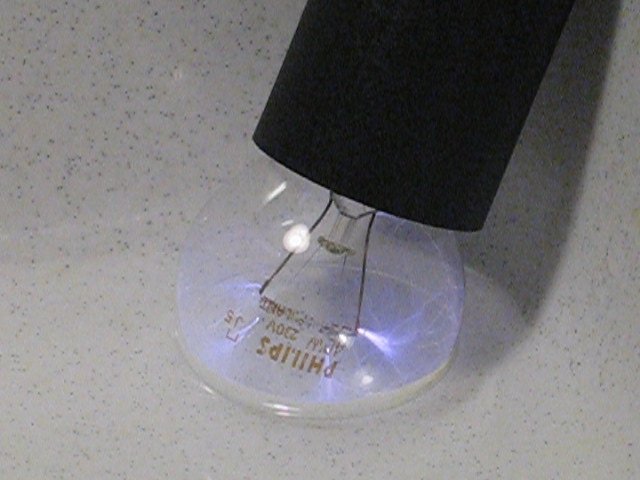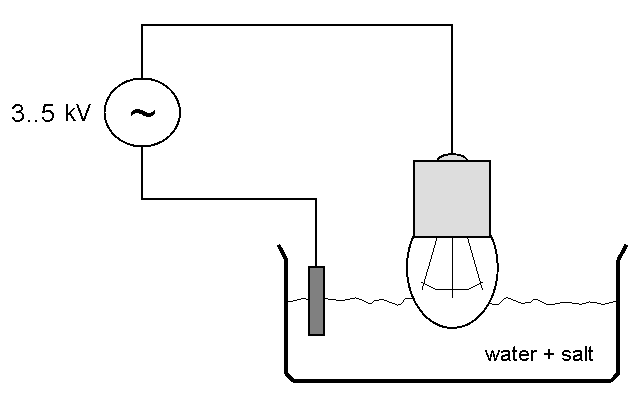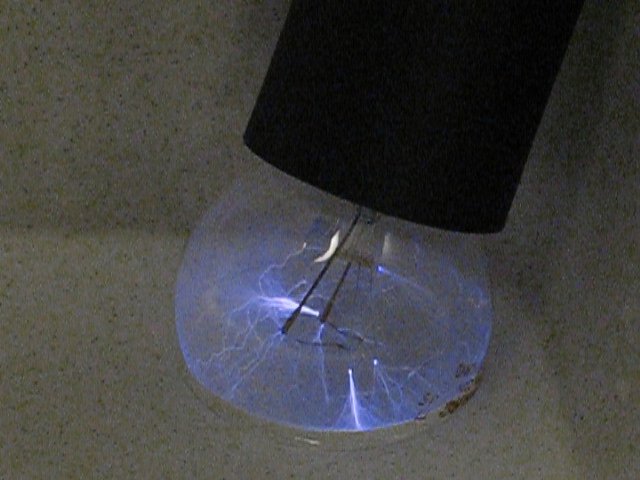


Plasma globe with normal light bulb
In this experiment, a high AC voltage is applied between a light bulb's glowing spiral and the outside of the glass. This high voltage is applied through water, such that the high potential difference exists along a large part of the surface of the glass bulb. This results in sparking throughout the entire bulb and this is accompanied with a weird ringing sound. Actually, the experiment is quite impressive.

This is a dangerous experiment, involving lethally high voltages, combined with a wet setup. This is a particularly dangerous combination and one must be VERY careful not to get electrocuted. The currents, involved in this experiment also are of sufficient magnitude to kill a grown up person. When this experiment is performed, be absolutely sure that no young children or pets are around.
![]()
Required equipment:
- high voltage AC source (somewhere between 3 kV and 5 kV, 50 Hz or 60 Hz), capable of delivering 10 mA or so. A neon sign transformer is most suitable, especially if its input voltage can be varied somewhat. If a stiff power supply is used with good voltage regulation, then a large high voltage 500 kΩ resistor MUST be used in series with the light bulb, otherwise the bulb may explode and/or the power supply will be destroyed!
- standard 230 V light bulb, with a transparent glass bulb
- tub, filled with water
- salt
Safety:
-
 The voltage,
used in this experiment is really high, and this is combined with rather
high currents. This combination is LETHAL. Be very careful not to touch any
part of the circuit while it is operational.
The voltage,
used in this experiment is really high, and this is combined with rather
high currents. This combination is LETHAL. Be very careful not to touch any
part of the circuit while it is operational. -
 In this
experiment, one is working with salted water, which is a good conductor.
This makes the experiment even more dangerous. Wet trails of water on the
table, drops on the floor, etc, make this a particularly risky experiment
and one has to be sure that nowhere outside of the tub, and near the setup,
there is any water or salt.
In this
experiment, one is working with salted water, which is a good conductor.
This makes the experiment even more dangerous. Wet trails of water on the
table, drops on the floor, etc, make this a particularly risky experiment
and one has to be sure that nowhere outside of the tub, and near the setup,
there is any water or salt.
![]()
Setup of the experiment
The circuit for this experiment is quite simple. The only special thing of this circuit is how the lamp/bulb is connected. It only is connected electrically at one end. The other end of the connection is through the glass bulb! The circuit, used in this experiment is as follows:

The practical setup of how the bulb is partly immersed in the water is shown in the following picture:

The white wire and the yellow wire are connected to the two leads of the power supply. To the water in the tub, a small amount of salt is added, such that it is made a little bit more conductive.
The bulb itself is put in a screw fitting and the wires of the fitting are connected to the power supply. The light bulb itself is a plain 40 W, 230 V transparent bulb, as shown in the picture below.

![]()
Performing the experiment
Once the circuit is setup correctly, performing the experiment is as simple as switching on the power supply. Before switching on, check and double-check all connections and assure that nothing outside the tub can get in contact with the high voltages and assure that everything is dry outside the tub with water.
When the power is switched on, a weird ringing noise is produced and all kinds of sparks are created inside the bulb. These sparks are going through the gas inside the bulb and are starting at the glowing spiral and are moving towards the glass of the bulb. The two pictures, given here, show the effect. The upper picture was made with normal background light, the second picture was made in a very dimly lit room.


Two videos are made of the sparking and plasma in the light bulb. Also take notice of the sound, the bulb makes a peculiar ringing noise, combined with the crackling of the sparks. Here follow the links of the two videos: bulb with sparking, bulb with sparking in dark room. Both files have a size of approximately 2 MByte.
![]()
Discussion of results
In normal air, a voltage of 4 kV can only create sparks with a length of a few mm. Inside the glass bulb, the pressure of the gas is much lower than in air, and this lower pressure results in a lower breakdown voltage of the gas mix. A voltage of 4 kV then easily makes sparks of at least a cm. Once a spark exists, current can remain flowing through it.
The experiment also shows that the sparks remain in existence along approximately the same path, although there is some jumping around of the sparks. This also can be explained. An existing path is hot, and it is ionized. Such a path has a lower resistance than the gas around it. So, once a path exists, the current will keep this path. The current keeps it hot and ionized, and this makes an existing path self-supporting.
The sparks are only going to the glass, which is immersed in the water. The reason for this is that the water is conductive and of much lower resistance than the gas mixture and the air outside the bulb. The current seeks an easiest path, and that path is not going through air.
Most remarkable is that the current seems to go through glass. This is only possible because of the use of an AC power supply. The water/glass/gas interface acts like a capacitor, the glass being the isolator between the gas inside the bulb and the water in the tub. The capacitor's impedance is relatively low to the high resistance of the gas inside the bulb and this allows a current to flow. If a DC voltage were applied, then after a tiny initial flow of current, the effect would come to an halt, with the full applied voltage across the glass. The glass is thick enough to have no breakdown and hence, after the initial charging of the "capacitor" no current would flow anymore.